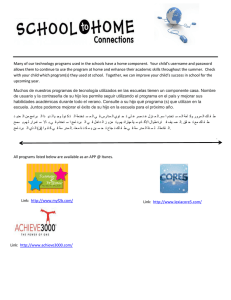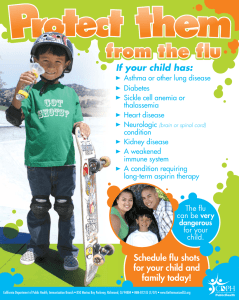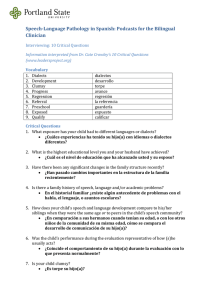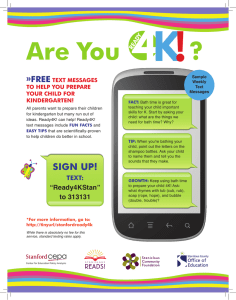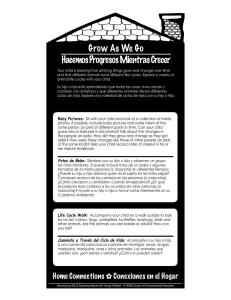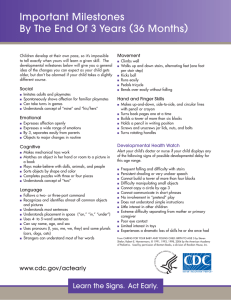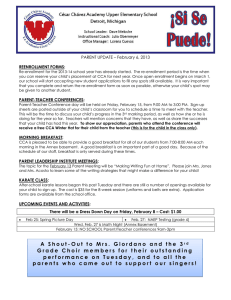PE173S Care After Reimplant Surgery for Urinary Reflux
Anuncio
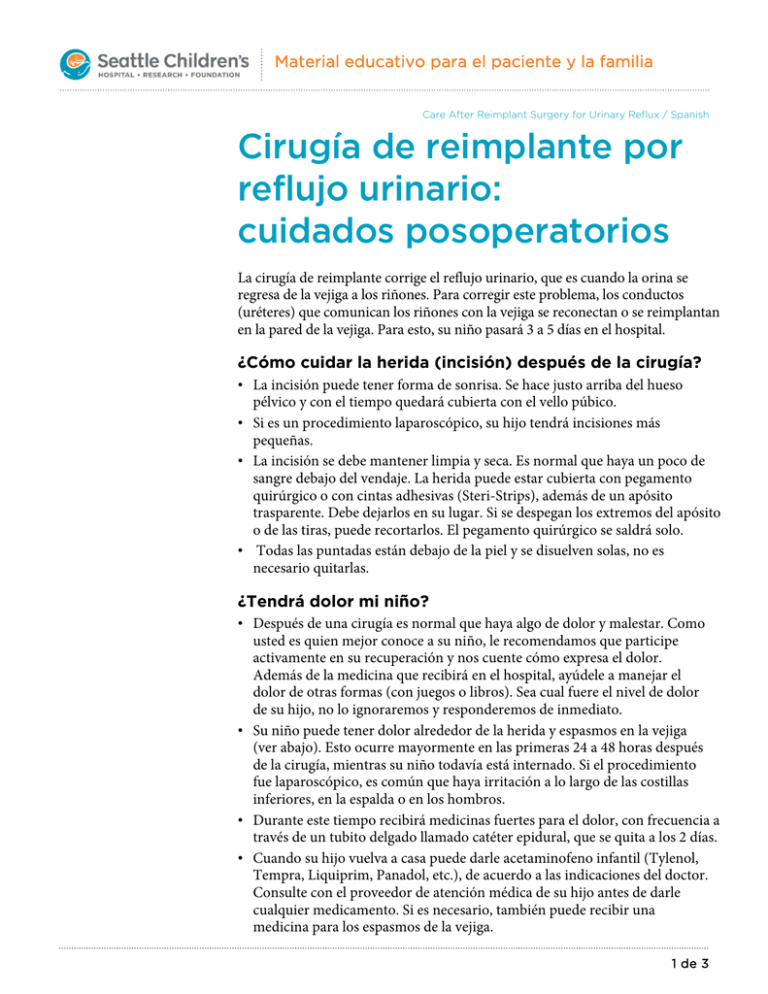
Material educativo para el paciente y la familia Care After Reimplant Surgery for Urinary Reflux / Spanish Cirugía de reimplante por reflujo urinario: cuidados posoperatorios La cirugía de reimplante corrige el reflujo urinario, que es cuando la orina se regresa de la vejiga a los riñones. Para corregir este problema, los conductos (uréteres) que comunican los riñones con la vejiga se reconectan o se reimplantan en la pared de la vejiga. Para esto, su niño pasará 3 a 5 días en el hospital. ¿Cómo cuidar la herida (incisión) después de la cirugía? • La incisión puede tener forma de sonrisa. Se hace justo arriba del hueso pélvico y con el tiempo quedará cubierta con el vello púbico. • Si es un procedimiento laparoscópico, su hijo tendrá incisiones más pequeñas. • La incisión se debe mantener limpia y seca. Es normal que haya un poco de sangre debajo del vendaje. La herida puede estar cubierta con pegamento quirúrgico o con cintas adhesivas (Steri-Strips), además de un apósito trasparente. Debe dejarlos en su lugar. Si se despegan los extremos del apósito o de las tiras, puede recortarlos. El pegamento quirúrgico se saldrá solo. • Todas las puntadas están debajo de la piel y se disuelven solas, no es necesario quitarlas. ¿Tendrá dolor mi niño? • Después de una cirugía es normal que haya algo de dolor y malestar. Como usted es quien mejor conoce a su niño, le recomendamos que participe activamente en su recuperación y nos cuente cómo expresa el dolor. Además de la medicina que recibirá en el hospital, ayúdele a manejar el dolor de otras formas (con juegos o libros). Sea cual fuere el nivel de dolor de su hijo, no lo ignoraremos y responderemos de inmediato. • Su niño puede tener dolor alrededor de la herida y espasmos en la vejiga (ver abajo). Esto ocurre mayormente en las primeras 24 a 48 horas después de la cirugía, mientras su niño todavía está internado. Si el procedimiento fue laparoscópico, es común que haya irritación a lo largo de las costillas inferiores, en la espalda o en los hombros. • Durante este tiempo recibirá medicinas fuertes para el dolor, con frecuencia a través de un tubito delgado llamado catéter epidural, que se quita a los 2 días. • Cuando su hijo vuelva a casa puede darle acetaminofeno infantil (Tylenol, Tempra, Liquiprim, Panadol, etc.), de acuerdo a las indicaciones del doctor. Consulte con el proveedor de atención médica de su hijo antes de darle cualquier medicamento. Si es necesario, también puede recibir una medicina para los espasmos de la vejiga. 1 de 3 Cirugía de reimplante: cuidados posoperatorios ¿Qué es un espasmo de vejiga? Un espasmo de vejiga es una contracción, calambre o rigidez de los músculos en la pared de la vejiga. A veces ocurren: • Cuando la sonda urinaria irrita la pared de la vejiga. • Cuando la sonda urinaria se dobla o se bloquea. • A causa del proceso de cicatrización en la pared de la vejiga. Estos espasmos tienden a durar menos de un minuto y ser dolorosos. Después de un espasmo puede aparecer sangre en la orina; es normal y no causa daño a su niño. ¿Tendrá mi hijo una sonda para la orina? • Después de la cirugía, su hijo tendrá una sonda de drenaje por 3 a 5 días para mantener la vejiga vacía. • Antes de retirar la sonda, el médico puede pedirle a la enfermera que la cierre con una pinza para que el niño se acostumbre a orinar solo. • Después de retirarla, puede tener algunas molestias para orinar. • Puede que también le dejen stents uretrales. Son pequeños tubos internos que mantienen los uréteres abiertos. Se retiran en una breve cirugía ambulatoria entre 6 y 8 semanas después de la primera. Consulte el folleto "Stents uretrales" en www.seattlechildrens.org/pdf/PE1949s.pdf. ¿Qué hago si mi niño regresa al hogar con una sonda? • Usted aprenderá los cuidados para la sonda y cómo cambiar la bolsa de orina. • Consulte el folleto Cuidados para la sonda uretral de Seattle Children’s. • Si su hijo sale del hospital con la sonda, se la quitaremos en una semana. ¿Habrá sangre en la orina? Cuando llegue la hora de salir del hospital su hijo todavía puede tener un poco de sangre en la orina. Se aclarará en las próximas semanas, pero puede aparecer más sangre después cuando juegue o haga actividades fuertes. Esto es normal y no causa daño. Si se ven coágulos de sangre en la orina, llame a Urología. ¿Cuándo puede comenzar a bañarse y regresar a sus actividades? • Por lo general, puede bañarse 2 días después de la cirugía. Consulte con el doctor de su hijo. • La mayoría de los niños debe evitar trepar, andar en bicicleta, las clases de gimnasia y los deportes por 1 mes. Después de eso puede reanudar todas sus actividades. Hable con el doctor sobre el plan para su hijo. 2 de 3 Cirugía de reimplante: cuidados posoperatorios Para más información • Urología 206-987-2509 • Operadora 206-987-2131 • Consulte con la enfermera o el doctor de su niño • www.seattlechildrens.org ¿Qué puede comer mi hijo? • Le llamaremos 2 días antes de la cirugía para darle instrucciones para la comida del día de la cirugía. • Antes del alta su hijo estará comiendo normalmente. • Debe tomar la mayor cantidad posible de líquidos. Si la orina se ve clara en el inodoro, su niño está bebiendo lo suficiente, • Ofrézcale una variedad de frutas y verduras para prevenir el estreñimiento. Es más difícil orinar cuando el intestino está lleno de materia fecal. Además, contribuye a los espasmos y al dolor de la vejiga después de la cirugía. ¿Mi hijo continuará tomando antibióticos? Probablemente necesitará continuar con una dosis baja de antibióticos. Los debe a la hora de acostarse, que es cuando más tiempo pasará sin vaciar la vejiga. Servicio gratuito de interpretación • En el hospital, solicítelo a la enfermera. • Fuera del hospital, llame a la línea gratuita de interpretación: 1-866-583-1527. Dígale al intérprete el nombre de la persona o la extensión que necesita. ¿Cuándo debo llamar al doctor? Llame al doctor de su niño en caso de: • • • • • • • Fiebre de 101.5°F o escalofríos. Vómitos. La herida o alrededor de la sonda la piel se pone roja, supura o se hincha. Dolor fuerte y constante que no se alivia con las medicinas para el dolor. Coágulos de sangre en la orina. Tiene una sonda permanente que ha dejado de drenar orina. Síntomas de infección urinaria, incluyendo: • Fiebre. • Irritabilidad. • Ardor al orinar. • Deseo frecuente de orinar o mucha urgencia. • Orina con mal olor, turbia o con sangre. • Se orina encima aunque va al baño solo. Si tiene preguntas o inquietudes, llame a la enfermera de Urología al 206-987-2509. Fuera de horario de oficina o en fines de semana, llame a la operadora al 206-987-2131 y pida hablar con el urólogo de guardia. Seattle Children's ofrece servicio gratuito de interpretación para pacientes, familiares y representantes legales sordos, con problemas de audición o con inglés limitado. Seattle Children's tendrá disponible esta información en formatos alternativos bajo solicitud. Llame al Centro de Recursos Familiares al 206-987-2201. Este volante fue revisado por el personal clínico de Seattle Children's. Sin embargo, como las necesidades de su niño son únicas, antes de actuar o depender de esta información, por favor consulte con el proveedor de atención médica de su hijo. © 1994, 2003, 2007, 2010, 2015 Seattle Children’s, Seattle, Washington. Todos los derechos reservados. Urología 12/15 Tr (lv/jw) PE173S 3 de 3 Patient and Family Education Care After Reimplant Surgery for Urinary Reflux Reimplant surgery fixes urinary reflux. This is a condition in which urine travels from the bladder back up to the kidneys. To correct this problem, the tubes from the kidneys to the bladder (the ureters) are reattached or reimplanted in the bladder wall. Your child will be in the hospital for 3 to 5 days when having this surgery. How do I care for the cut (incision) after surgery? • The incision may be in the shape of a smile. It is just above the pelvic bone. This will not be visible later in life, since it will someday be covered by hair. • If your child had a laparoscopic procedure, the incisions are smaller. • The incision should look clean and dry. A little blood under the bandage is normal. The incision may be covered with surgical plastic glue or small pieces of tape (Steri-Strips) and a clear bandage. These should be left in place. If the bandage or strips curl up at the ends, they can be trimmed. The surgical glue will peel off on its own. • Any stitches are under the skin and will dissolve on their own. They do not need to be removed. Will my child have pain? • After a surgery some pain and discomfort is normal. You know your child best. We encourage you to take an active part in your child’s recovery by talking with your care team about how your child shows pain. In addition to medicine given while in the hospital, encourage coping tools (like games or books) to treat pain and provide support. No matter the level of your child’s pain, we also believe that they are hurting and will respond right away. • Your child may have some pain around the incision and may have bladder spasms (see below). The most discomfort occurs 24 to 48 hours after surgery while your child is still in the hospital. If your child has a laparoscopic procedure, irritation along the lower ribs, back or shoulder is common. • Your child will be given stronger medicines during this time to lessen the pain, often through a thin tube called an epidural catheter. This tube is removed in 2 days. • When your child is back home, use children’s acetaminophen (Tylenol, Tempra, Liquiprim, Panadol, etc.) as directed by your child’s doctor. Check with your child’s healthcare provider before giving any type of medicine to your child. Your child may also be given medicine for bladder spasms, if needed. 1 of 3 Reimplant Surgery: Care Afterwards What is a bladder spasm? A bladder spasm is a contraction, cramp or tightening of muscles in the bladder wall. Causes of bladder spasms include: • When the urinary catheter irritates the bladder wall • When the urinary catheter gets kinked or blocked • When the bladder wall is healing A bladder spasm usually lasts less than a minute and can cause your child to wince. You may also see your child pee urine that is tinged with blood after a spasm. This is normal and should not harm your child. Will my child have a tube (catheter) to drain urine? • After surgery, your child will have a drainage catheter for 3 to 5 days to keep the bladder empty. • Before the catheter is taken out, your doctor may have your nurse clamp the catheter so your child can get used to peeing on their own. • After the catheter is taken out, your child may have some discomfort peeing for awhile. • Your child may also have ureteral stents. Ureteral stents are small internal tubes that keep the ureters open. Stents need to be removed in a second, very brief day surgery 6 to 8 weeks after the first surgery. For more information, read our handout “Ureteral Stents” www.seattlechildrens.org/pdf/PE1949.pdf. What if my child goes home with a catheter? • You will be taught how to take care of the catheter and change the urine bag. • Please read the Seattle Children’s flyer called Indwelling Urinary Catheter Care, www.seattlechildrens.org/pdf/PE117.pdf. • If your child does go home with a catheter, it will be taken out in about a week. Will there be blood in the urine? Your child’s urine may still be pink when it is time to go home. It will clear up in the next few weeks, but may become bloodier after vigorous play or activity. This is normal and should not harm your child. If there are blood clots in your child’s urine, call the Urology Clinic. When can bathing and activity begin? • Most often, your child can bathe as usual 2 days after surgery. Ask your child’s doctor. • Most children should avoid climbing, biking and gym class and sports for 1 month. After that time, it is OK to do all usual activities. Ask your child’s doctor about your child’s plan. 2 of 3 Reimplant Surgery: Care Afterwards To Learn More • Urology 206-987-2509 • Paging Operator 206-987-2131 • Ask your child’s nurse or doctor • www.seattlechildrens.org What can my child eat? • We will call you 2 days before to surgery with instructions about what to eat before surgery. • Your child will be back to their regular diet by the time it is time to go home from the hospital. • Ask your child to keep drinking as much liquid as possible. If your child is drinking enough, their urine should be clear in the toilet. • Offer a variety of fruit and vegetables. This will help prevent constipation. It is harder to pee when the bowel is full of stool. Constipation will increase bladder spasms and pain after surgery. Will my child still continue with the antibiotic? Free Interpreter Services • In the hospital, ask your child’s nurse. • From outside the hospital, call the toll-free Family Interpreting Line 1-866-583-1527. Tell the interpreter the name or extension you need. Your child probably will need to continue a low dose of the antibiotic. Give the medicine at bedtime when the bladder goes for longest time without emptying while your child sleeps. When should I call the doctor? Please call your doctor if your child: • • • • • • • Has a fever of 101.5°F or chills Is vomiting Has redness, drainage or swelling of the incision or the SP catheter sites Has severe, constant pain that is not helped by pain medicines Ongoing blood clots in the urine Has an indwelling catheter that has stopped draining urine Has symptoms of a urinary tract infection, including: • Fever • Irritability • Burning when they pee • Needing to pee very often or very badly • Smelly, cloudy or bloody urine • Wetting if otherwise potty trained If you have questions or concerns, please call the nurse in the Urology Clinic at 206-987-2509. After hours or on weekends, call the paging operator and ask for the urologist on-call: 206-987-2131. Seattle Children’s offers interpreter services for Deaf, hard of hearing or non-English speaking patients, family members and legal representatives free of charge. Seattle Children’s will make this information available in alternate formats upon request. Call the Family Resource Center at 206-987-2201. This handout has been reviewed by clinical staff at Seattle Children’s. However, your child’s needs are unique. Before you act or rely upon this information, please talk with your child’s healthcare provider. © 1994, 2003, 2007, 2010, 2015 Seattle Children’s, Seattle, Washington. All rights reserved. Urology 12/15 PE173 3 of 3

